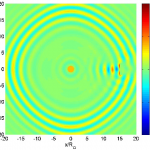It is widely acknowledged that hybrid modeling approaches for dynamical problems allow for taking advantage of specific features of the methods involved in a hybrid model. Such coupling strategies are typically difficult to establish, especially for transient dynamics. The main sources of difficulties are different spatio-temporal discretization approaches, and mathematical formulations. Another issue is related to high computational burden, i.e. hardware resources and calculation times, associated with required high spatio-temporal resolutions of the models. An ideal hybrid coupling strategy allows waves to propagate through models’ common interface undisturbed. Apart from difficulties mentioned above, different numerical methods employed in the hybrid model display different numerical dispersion properties that must be accounted for.
The requirements for a hybrid model are similar to those for the multiscale model, as the hybrid models may be considered as certain class of multiscale problems. It is assumed that the hybrid model should be superior over the numerical models involved in the coupling, with the assumption of equal resolution of the selected quantity that is analyzed. The following goals may be formulated for the hybrid approach: (1) the coupling does not introduce additional limitations to the model, e.g. in terms of stability conditions or characteristic simulation parameters (time step, element size, etc.), (2) minimal required degrees of freedom are introduced to the model, (3) numerical dispersion effects introduced by the coupling are minimized. Both, inconsistent meshes and time stepping procedures, may be used.
Our works related to hybrid modeling techniques for wave propagation are mainly concerned with local computational strategies (i.e. LISA and CA), their mutual coupling and interaction with other methods (e.g. Finite Elements).

